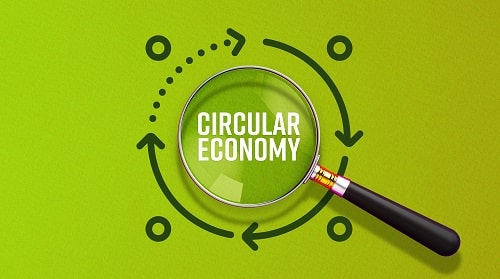Poor indoor air quality in workplaces and homes is a major risk to our health, making it essential we improve our scientific knowledge of the dangers of air pollutants like chemicals.
Features
The air we breathe
Indoor air quality has gained renewed importance in public awareness, especially in the current time of the coronavirus pandemic. Through fog-filled glasses, condensation on our skin and a rub from the elastic on the back of our ears, we are acutely aware of our breath through our colour co-ordinated masks, consciously considering the make-up of the air we are breathing.
The 21st century invisible predator
Our air is becoming a toxic soup, an aerial dumping ground that surrounds us, creating a 21st century invisible predator. It affects us all, causing liver and kidney damage, cancer and depression, increases our allergen and asthmatic conditions and can impact on our comfort and productivity. The World Health Organization (WHO) has identified air quality as one of the top five health hazards in the world. And yet this predator is unseen, often invisible to our senses and is frequently considered as low risk.
 Our air is becoming a toxic soup, an aerial dumping ground that surrounds us, creating a 21st century invisible predator. Photograph: Simon Morris
Our air is becoming a toxic soup, an aerial dumping ground that surrounds us, creating a 21st century invisible predator. Photograph: Simon Morris
Every year, up to 40,000 deaths in the UK are attributable to exposure to outdoor air pollution and over 12 million people here are living with health issues that can be exacerbated by air pollution. Three million working days are lost every year because the UK’s air pollution exceeds the WHO’s recommended limits. This costs the UK’s health service and businesses more than £20 billion every year.
The focus on outdoor air pollution has received increasing public attention, although we wait to see how ambitious the government will be when it sets legally binding air quality targets later this year. However, indoor air concentrations of pollutants are often two to five times higher than outdoors. This stealth hazard cannot be escaped – it envelops our indoor environments. As most people spend approximately 90 per cent of their time indoors, we are therefore exposed to indoor pollutants to a much greater extent than outdoors.
In addition, various indoor pollution sources add to the composition of pollutants in the indoor air. These include building materials, furnishings, asbestos-containing insulation, radon, unvented heating and cooking stoves, products such as air fresheners and cleaning solutions, and a multitude of occupants’ activities, including drying clothing indoors, smoking and DIY.
As we become more aware of our environmental obligations to protect our energy resources, and perhaps our pockets, our home and work environments are becoming more airtight to insulate against energy loss. Many of these pollutants found indoors will be low level, but due to inadequate ventilation, high humidity levels and warm temperatures, the airborne contamination in our homes and workplaces can crescendo to an unacceptable cocktail of emissions and remain in the air for long periods of time.
Inequality of the air we breathe
Air pollution threatens us all, but the impact is not equal. If you are in the low to medium income band, your exposure risks are higher. More than 80 per cent of people living in urban areas which monitor air pollution are exposed to air quality levels that exceed WHO guideline limits, according to the UN, with 98 per cent of low-and middle-income countries suffering from the highest exposures.
There is considerable evidence to suggest that the health of people of lower socio-economic status tends to be more affected by air pollution than the health of the general population. Inequality has been highlighted by the pandemic, and deaths from Covid-19 seem to have affected the most deprived areas of England disproportionately, with twice the number of deaths than more affluent areas. Sadly, this is not a unique phenomenon, but it has highlighted the injustice and led to government policy decisions aimed at tackling health inequalities.
 Air pollution threatens us all, but the impact is not equal. If you are in the low to medium income band, your exposure risks are higher. Photograph: iStock
Air pollution threatens us all, but the impact is not equal. If you are in the low to medium income band, your exposure risks are higher. Photograph: iStock
There are three main areas where the health of people in low-social economic communities is adversely impacted:
- Increased susceptibility to poor health outcomes due to pre-existing health burdens, such as chronic stress, smoking/alcohol-related conditions, fewer opportunities to choose healthy behaviours
- These areas have poorer outdoor and indoor environments, including the quality of air (for example, they are near to industry or busy roads, and have less green space)
- People have less access to jobs, healthy food, decent housing and medical care, all of which contribute to poorer health.
Other factors, such as age, gender, race, new and expectant mothers, pre-existing conditions and hypersensitivity, can increase the effects of poor indoor air quality.
The Office for Health Improvement and Disparities – which focuses on improving the health of people in England and reducing health inequalities – states that exposure to air pollution is one of the leading causes of preventable health problems in England.
It is estimated that 15 million people in England are suffering from long-term chronic disease, and these people account for up to 80 per cent of GP consultations. So, providing better support for GPs so they can deliver advice to patients on how to improve the quality of the air they are exposed to would help to reduce this burden.
For example, GPs could advise patients about how to reduce their exposure to air pollution, such as by wearing respiratory protection if they work with hazardous substances or when doing DIY, and avoiding pollution hotspots like main roads. The Action for Clean Air Campaign is running a pilot where GPs in London are given the information they need to have effective conversations with patients about the actions everyone can take to reduce their exposure to air pollution.
Nine-year-old Ella Adoo-Kissi-Debrah, who lived 25 metres away from the busy South Circular Road in London, died in 2013, after suffering 28 months of seizures and making 28 visits to the hospital for breathing problems. An inquest found that the cause of death was acute respiratory failure and severe asthma.
In 2020, the coroner concluded “air pollution was a significant contributory factor to both the induction and exacerbation of her asthma” and called for a change in the law to reduce the UK’s limits for particulate matter pollution to bring them in line with WHO guidelines.
It is estimated there are 28,000–36,000 deaths from air pollution every year in the UK. Ella is the first person in the UK to have air pollution listed as a cause of death and the coroner’s ruling therefore establishes a critical link between cause and effect.
Through the bravery and tenacity of Ella’s mother, Rosamund Kissi-Debrah, in raising the agenda and fighting for justice, the UK government has responded with a number of major reform proposals to tackle air quality, including the recent introduction of the Environment Act 2021.
The Act is only a foundation, and will rely on further regulations, standards, policies, targets and enforcement to protect our future health and environment. However, when it recently launched its consultation on the environmental targets, the government showed a disappointing lack of ambition on air pollution by giving itself until 2040 to reach limits on levels of tiny particulate matter the WHO had advised we should meet back in 2005.
Before a child is even born, air pollution can cross the placenta and disrupt a baby’s development and growth. Exposure to air pollution can increase a pregnant woman’s likelihood of experiencing a miscarriage by 50 per cent. If that child is born into a low-income household, it is 70 per cent more likely to develop asthma. The systemic inequalities of poor social housing, living near external pollutants, low-income occupations and limited access to healthcare results in a high susceptibility to health conditions from air pollution.
 Julie Riggs, British Safety Council's senior head of education has also written a book on indoor air quality, A Practical Guide to Indoor Air Quality
Julie Riggs, British Safety Council's senior head of education has also written a book on indoor air quality, A Practical Guide to Indoor Air Quality
As financial inequalities rise – with predicted higher fuel bills, lower incomes and increases in personal debt – the divide of health inequalities will become greater. Conceivably, this rise may result in a reduction in quality of life and an increase in morbidity and mortality.
As our awareness of the health risks from poor external air quality improves, it would therefore seem logical that the standards, focus and resources being applied to reduce outdoor air pollution must be applied with equivalent urgency to improving indoor air quality. With more of us working from home, we should not discriminate or differentiate in our standards for good air quality between home, workplaces and/or public spaces.
We expect the food we eat, the air we breathe and the water we drink to be uncontaminated and safe. As educated consumers we can, to some extent, control what we ingest (depending on factors like labelling of ingredients). But our most vital organs, our lungs, continue to be affected by the harmful contaminants in the air we breathe every day.
It is not enough to understand the world, we need to change it
Our awareness of the air we breathe has been heightened with the pandemic. Indeed, the market for indoor air quality solutions is flourishing and predicted to grow significantly. Ventilation systems, air filtration and purifiers – even air cleaning sprays and odour neutralisers – are filling our homes and workplaces. The commercial market is responding to consumers’ concerns.
Our love affair with scented candles and air fresheners is increasing, satisfying our olfactory craving to create ‘fresh’ and ‘clean’ spaces. Supermarkets devote dedicated packed aisles to such consumer demands, with products advertising organic, plant-based, home-made, ‘natural’ air fresheners and candles. Some manufacturers claim their products can clean or disinfect the air, which is scientifically difficult to verify.
This kind of misinformation and potentially inaccurate labelling can cause confusion among those who use these products in homes and workplaces. The available guidance needs to be improved so people can distinguish between solutions and products effective at improving indoor air quality and those that either merely mask an indoor air quality problem or even exacerbate it by adding more chemicals to the air.
Perfumes and scents used in indoor settings are a subject many of us can relate to and are a good example of how we need to educate occupants to recognise the hazards of indoor air pollutants.
Despite the various literature discussing indoor air quality, there has been a gap in understanding occupants’ reactions to a pollutant based on their opinion of the risk it poses. 95 per cent of the chemicals used in fragrances today are synthetic compounds derived from petroleum. There is substantial literature linking various health effects to exposure to synthetic compounds derived from petroleum, including respiratory disorders, cancer, birth defects, central nervous system disorders, allergic respiratory reactions, skin and eye irritations and indeed even a link to depression.
However, if an air pollutant either has no scent or the smell is pleasant, our perception of the possible health risk it may pose is skewed. Cigarette smoke contains similar compounds to many scents, such as benzene, formaldehyde and toluene. Smokers fully know the risks from smoking but continue to do so, as the perceived pleasure outweighs the risk. However, many people are unaware that scents used in products designed to ‘freshen’ the indoor air may contain these harmful compounds, and further education and awareness is required so they understand the risk from inhaling scents that contain them.
Therefore, to engage in a sensible debate on indoor air quality, not only do we need to educate, but we also need to persuade.
We must strengthen our understanding of indoor air quality, and the key risk factors and health effects it can pose in all indoor environments. Further research is needed to explore bio-monitoring and multi-substance assessments, so we can gain better scientific insight into how different substances and air pollutants interact with each other, and what impact this could have on human health.
Better guidelines, legislation and limits must be explored and introduced so we gain a better understanding of the possible health impacts of continuous, low-level and long-term exposure to air pollutants. We also need to do more to protect low socio-economic communities, occupants of social housing and those at risk of occupational exposure to indoor and outdoor air pollution. Further research and transparency of data is required to ensure we make better informed policy decisions on air quality – indoors and outside.
A coordinated effort is required. Healthcare professionals, architects, builders, housing associations, landlords and property managers, education institutions, organisations and government must work collaboratively with a clear objective of tackling the long-term impact on both physical health and the economy from air pollution.
Employers and health and safety practitioners have the potential to contribute towards the dialogue on improving social and public health. Many employers already recognise the importance of providing effective employee wellbeing programmes that support myriad health promotions and interventions at work.
The correlation between the economic and social impact of indoor air quality is evolving. Studies have shown that many measures that improve indoor air quality can be cost-effective – for example, by reducing sickness, reducing absence from work and increasing people’s performance.
Employers and health and safety practitioners have a pivotal role in influencing positively the health of their workers and contributing towards the health of the country. With air pollution being one of the biggest and growing threats to health, employers and safety practitioners need to consider the role they can play in creating positive change around air quality.
The British Safety Council’s Time to Breathe campaign is calling for outdoor workers to be better protected from the health risks posed by ambient air pollution: https://www.britsafe.org/campaigns-and-policy/time-to-breathe-air-pollution-campaign
A Practical Guide to Indoor Air Quality: For the Home and Workplace, by Dr Julie Riggs, is available on Amazon here
Dr Julie Riggs is Senior head of education at the British Safety Council
FEATURES

How to build circular economy business models
By Chloe Miller, CC Consulting on 07 April 2025
Widespread adoption of a circular economy model by business would ensure greater environmental and economic value is extracted and retained from raw materials and products, while simultaneously reducing carbon emissions, protecting the environment and boosting business efficiency and reputation.

What does the first year on an accelerated net zero path have in store for UK businesses?
By Team Energy on 07 April 2025
The UK is halfway to net zero by 2050 and on a new, sped-up net zero pathway. In light of this, Graham Paul, sales, marketing & client services director at TEAM Energy, speaks to TEAM Energy’s efficiency and carbon reduction experts about the future of energy efficiency and net zero in the UK.

Aligning organisational culture with sustainability: a win, win for the environment and business
By Dr Keith Whitehead, British Safety Council on 04 April 2025
The culture of an organisation is crucial in determining how successfully it implements, integrates and achieves its sustainability and environmental goals and practices. However, there are a number of simple ways of ensuring a positive organisational culture where everyone is fully committed to achieving excellent sustainability performance.



